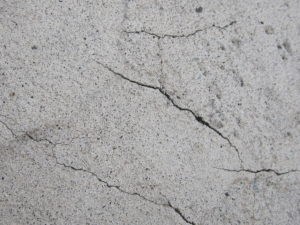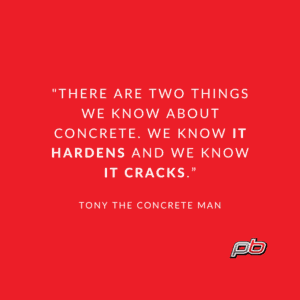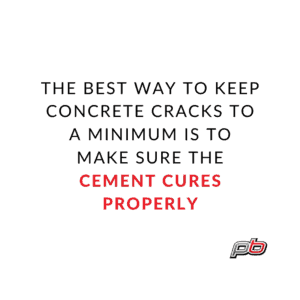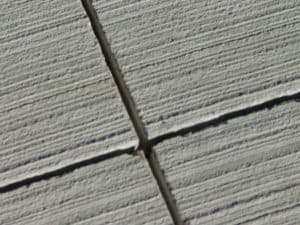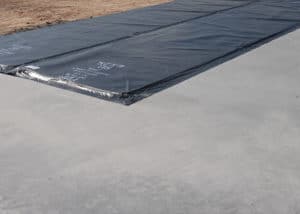How can you prevent concrete from cracking? According to Tony “The Concrete Man” Johnson, a concrete contractor located in Indiana, you can’t. “There are two things we know about concrete,” Johnson says. “We know it hardens and we know it cracks.”
We agree with Tony: concrete cracks are inevitable. That being said, a good contractor knows how to place concrete that will have minimal cracking over time.
Why Does Concrete Crack?
Before we jump into some tried and true ways to minimize concrete cracking, let’s take a look at what causes the cracks in the first place. Here are a few of the most common culprits:
- Shrinkage. Concrete shrinks just a bit as it cures (Typically ⅛ inch for every 20 feet) Sometimes, this is just enough stress to cause the concrete to crack.
- Excess Water- Extra water means extra shrinkage as the water evaporates. To avoid this, follow the instructions that accompany your concrete mix and make sure you’re using the correct type of mix for your job requirements.
- Tensile Stress. Concrete is designed to have a great deal of compressive strength, not tensile. While concrete isn’t typically exposed to huge amounts of tensile stress, if the internal tensile stresses are greater than the tensile strength, the concrete will inevitably crack.
- Poor Subgrade Prep– Without the proper support from a well-prepared subgrade, concrete will settle and crack as it cures. The subgrade should be thawed, even, uniform, and have positive drainage.
- Improper Curing– When moisture isn’t properly controlled during curing, the surface can lose moisture and cure more rapidly than the rest of the slab, causing map cracking. If heat isn’t adequately maintained during curing, concrete won’t adequately cure and more severe cracking can happen over time. We’ll talk a bit more about curing later on.
- Poorly placed joints– Joints give concrete a place to crack and relieve stress. When they aren’t placed properly, however, they are just a waste of time and do nothing to keep cracks under control. We’ll discuss this a bit more at the end of the article.
A Cure for Cracks
The best way to keep concrete cracks to a minimum is to do a kick-butt job at curing your concrete. This means going out of your way to ensure concrete stays warm and moist during cure time. Here are some common approaches to a well-executed cure:
- Spray curing concrete with water (also referred to as a “moist cure”- Frequently hosing down curing concrete with water (5 or more times/ day) for the first 7 days keeps the surface of the slab moist while the rest of the concrete continues to cure. This helps the entire slab to cure evenly.
- Keep Concrete covered- Instead of frequently spraying the concrete surface, you can wet it just once each day then use a cover that will trap the moisture. This is typically done for 7 days.
- Pond cure- Pond curing involves creating a temporary berm around the concrete slab then flooding it with one foot of water. This method takes just three days, but is not always feasible depending on the size and design of your project.
- Apply a curing compound- Curing compounds are sprayed onto curing concrete and create a protective film that prevents moisture from evaporating too quickly.
- Use heated blankets (when necessary)- When concrete isn’t kept above 50F during cure time, it won’t reach its full strength. If you’re planning a concrete project in cold weather or temperatures unexpectedly take a plunge during your concrete placement, there are a few different options for keeping things toasty. Our favorite solution is heated blankets.
Controlling the Crack: When and How to use Joints
Unfortunately, even the most expertly cured concrete is going to crack a bit. That’s where joints come in. Contraction/expansion joints give concrete a place to crack without compromising strength or visual appeal.
Tony the Concrete Man says, “Joints, placed properly, give concrete a place to relieve stress. The joint’s really important because pouring a concrete slab and then placing weight upon it tends to stress the concrete out.”
What Exactly is a Joint?
When you look at a finished slab of concrete, joints are the spaces or lines you see separating the entire area of concrete. They are formed by either placing plastic or hardboard strips into the wet concrete surface,cutting into the surface with a saw, or tooling into the concrete while it’s still wet.
Joint Placement
For joints to effectively control cracking, they absolutely must be placed correctly. This includes proper spacing and proper depth.
To calculate maximum acceptable spacing, multiply slab depth (in inches) by 36.
For example, if the concrete slab is 4” deep, the maximum acceptable joint spacing would be every 144 inches, or 12 feet.
To calculate necessary joint depth, divide total slab depth by 4.
For example, if the concrete slab is 4” deep, the joint would need to be 1” deep.
When to Joint Concrete
Joints should be added to concrete as soon as possible. Of course, this will depend on what type of joint is used. Plastic or hardboard strips can be added immediately. Hand tooled joints can also be placed while the concrete is still plastic and should be added with each successive pass of finishing. When using a saw, however, the jointing has to wait until the concrete can withstand the sawing. This is typically done within the first 18 hours of curing (Don’t wait longer than 24 hours).
Powerblanket can help
At Powerblanket, we get how important careful temperature control is to high-quality concrete placement. From thawing subgrade to keeping curing concrete warm and moist, we’ve got you covered!
Cure your concrete faster and better in cold weather conditions with Powerblanket.


